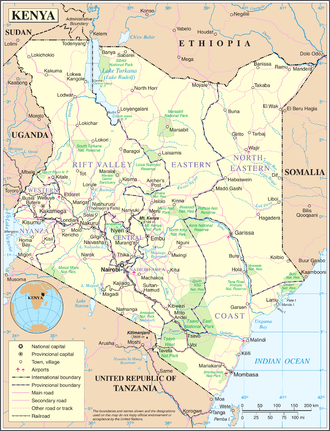At 580,367 km2 (224,081 sq mi),[7] Kenya is the world's forty-seventh largest country (after Madagascar). It lies between latitudes 5°N and 5°S, and longitudes 34° and 42°E. From the coast on the Indian Ocean, the low plains rise to central highlands. The highlands are bisected by the Great Rift Valley, with a fertile plateau lying to the east.
The Kenyan Highlands comprise one of the most successful agricultural production regions in Africa. The highlands are the site of the highest point in Kenya and the second highest peak on the continent: Mount Kenya, which reaches 5,199 m (17,057 ft) and is the site of glaciers. Mount Kilimanjaro (5,895 m or 19,341 ft) can be seen from Kenya to the South of the Tanzanian border.
Kenya's climate varies from tropical along the coast to temperate inland to arid in the north and northeast parts of the country. The area receives a great deal of sunshine every month, and summer clothes are worn throughout the year. It is usually cool at night and early in the morning inland at higher elevations.
The "long rains" season occurs from March/April to May/June. The "short rains" season occurs from October to November/December. The rainfall is sometimes heavy and often falls in the afternoons and evenings. The temperature remains high throughout these months of tropical rain. The hottest period is February and March, leading into the season of the long rains, and the coldest is in July and August.
| City | Elevation (m) | Max (°C) | Min (°C) | |
|---|---|---|---|---|
| Mombasa | coastal town | 17 | 32.3 | 23.8 |
| Nairobi | capital city | 1,661 | 25.2 | 13.6 |
| Kisumu | lakeside city | 1,131 | 31.8 | 16.9 |
| Eldoret | Rift Valley town | 2,085 | 23.6 | 9.5 |
| Lodwar | dry north plainlands | 506 | 34.8 | 23.7 |
| Mandera | dry north plainlands | 506 | 34.8 | 25.7 |

